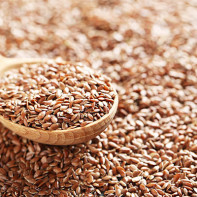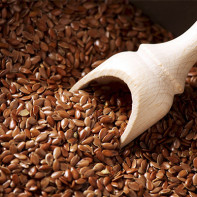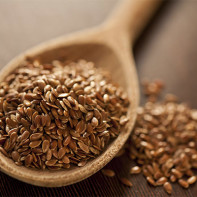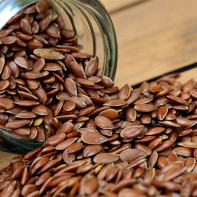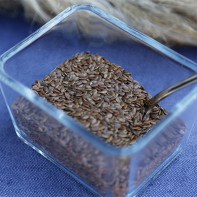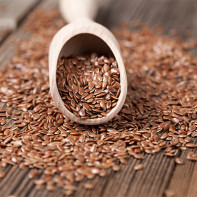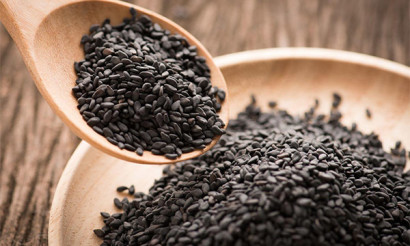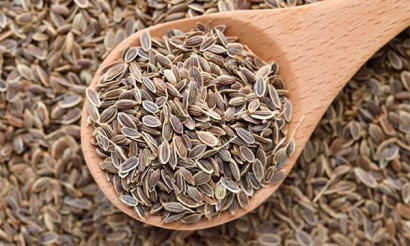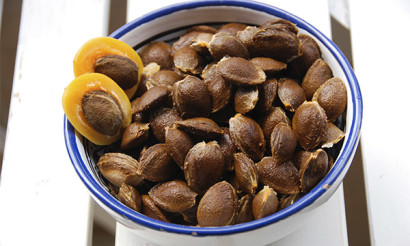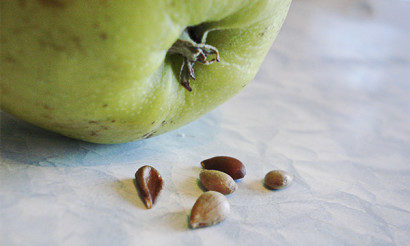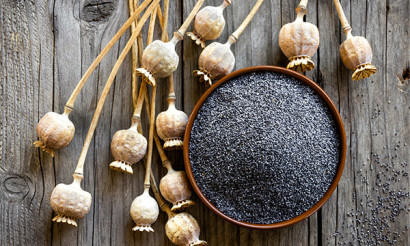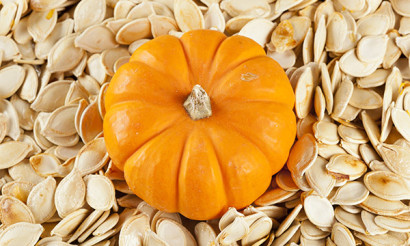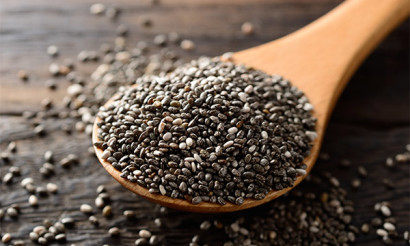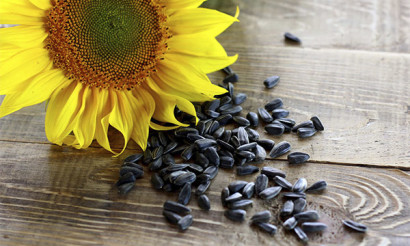Flax seed: useful properties and contraindications
Flax seeds are often called a superfood, and this is just the case when such a characteristic is justified. Flaxseed contains many useful substances, is widely used in folk medicine and at the same time has earned the recognition of official science. These small and unsightly at first glance seeds are an important preventive measure against quite serious diseases, including cancer, such as breast cancer.
- Types of flax seeds
- What is the difference between white and brown flax seeds
- Composition and Calories
- Useful properties of flax seeds
- For Women
- For Men
- Pregnancy
- Breastfeeding
- For children
- The benefits and harms of sprouted flax seeds
- How to Sprout
- How to use flax seeds oil
- Flax seed Urbech: Benefits and Harms
- Flaxseed meal
- How to use flax seeds for weight loss
- Flax seeds in medicine
- Diabetes mellitus
- Pancreatitis
- Gastritis
- For bowel
- For constipation
- For gout
- For colitis
- For the liver
- For hemorrhoids
- Pri cholecystitis
- Flax seeds in traditional medicine
- Flax seeds in cosmetology
- Flax Seed Masks for Face
- Hair Masks
- Flax seeds in cooking
- Harm and Contraindications
- How to choose and store flax seeds
- How to Eat Flax Seeds Properly
- How much can I eat per day?
- You can eat them at night and on an empty stomach.
- Can I Eat Flax Seeds Dry?
- Do we wash flax seeds before eating them?
- How to properly brew flax seeds
- What can be made of flax seeds: Recipes
- Flax porridge
- Kissel
- Smoothie
- Can we give flax seeds to animals?
- Interesting Facts about Flax Seeds
Flax Seed Types
Flaxseed comes in two varieties. The most common variant is dark brown seeds, but there are also light golden seeds, which are also called white.
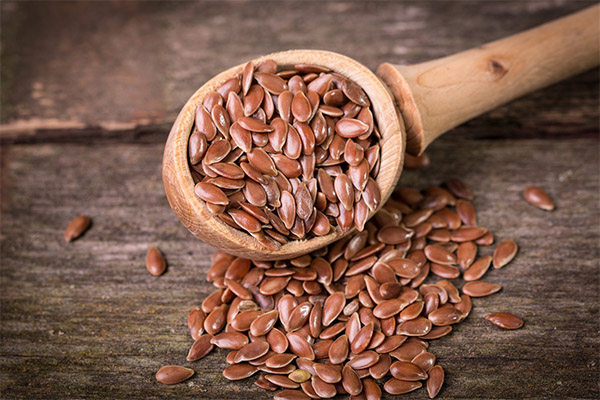
What is the difference between white and brown flax seeds
There is no fundamental difference in properties between the two species. However, it is believed that white seeds contain more antioxidants, and therefore more useful. In addition, dark brown seeds are slightly bitter, while light golden ones have a milder taste. Neither seed has a distinct smell. Flaxseed oil of both kinds has a light pleasant aroma and a nutty aftertaste.
White flax seeds are more often used in food, especially when it comes to dishes for children. They are easier to add to porridge or muesli, as they are not as noticeable as dark brown ones.
Composition and calories
Flaxseed is a fairly caloric product. Its energy value is 534 kcal per 100 g. At the same time, flaxseed has a unique composition. It includes:
- Polyunsaturated fatty acids (omega-3, 6 and 9). They are responsible for the normal functioning of the cardiovascular system, help lower blood pressure and reduce the level of "bad" cholesterol. These substances are an excellent preventive measure against heart attacks and cancer, and they also have a beneficial effect on brain function.
- Vitamins A and E (themselves are antioxidants that slow down the aging process), as well as groups B and F, useful for the nervous system, have a positive effect on the condition of skin, hair and nails. Also included in the composition of the seeds vitamins can be more effective in the fight against excess weight.
- Lignans are substances that have a marked antifungal and antiviral effect. They are phytoestrogens - plant hormone-like substances that in their action resemble female hormones. They help to improve feelings of well-being before menstruation or during menopause. Thanks to them the pain disappears, improves mood. They have anticarcinogenic effect, beneficial effect on reproductive function.
- Soluble fiber is what makes flaxseed useful for the intestines. It helps to normalize digestive processes, gets rid of constipation, strengthens the body's natural immune defense. This type of fiber increases with prolonged processing by the body, resulting in a feeling of satiety - this helps to reduce appetite and avoid additional snacking.
- Phytosterols are hormone-like substances found in plants. They generally act in the same way as hormones, including artificial hormones, but lack their disadvantages. Phytosterols help control cholesterol levels.
- Polysaccharides are substances that have many beneficial properties. They help to fight pathogens due to their enveloping properties. That is why they are necessary for gastritis and peptic ulcer disease.
- Selenium and lecithin - these two components help speed up the elimination of toxins from the body. They also improve vision and can inhibit the growth of tumors.
Flaxseeds also contain elements such as copper, phosphorus, magnesium and manganese, the importance of which for the body is difficult to overestimate.
Useful properties of flax seeds
Flaxseed has many useful properties. It helps strengthen the immune system, fights pathogenic microbes, has anti-inflammatory effects, normalizes the digestive system.
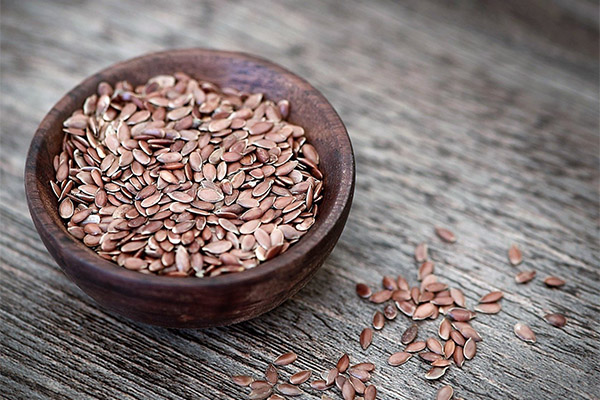
For women
Flaxseed is very useful for women because of its unique composition. First of all, of course, because of the presence of lignans, that is phytoestrogens, as they are good for reproductive function and protect against breast cancer. In addition, flaxseeds contain substances that have bactericidal action. This allows them to be used to treat cystitis, inflammatory diseases, cardiovascular system abnormalities, which are most often found in the fair sex.
For men
Studies show that men have a much higher risk of increasing "bad" cholesterol levels in the blood and of developing hypertension or other cardiovascular diseases than women. That is why they are recommended to eat flaxseed - it allows them to lower their cholesterol levels without taking medications.
In addition, the substances in this product significantly reduce the risk of prostatitis and prostate cancer. Also, studies carried out in the USA have proved that flaxseed is useful for diabetics, as it helps to reduce blood sugar levels and lose weight in the most natural way, securing a stable result. And it is overweight that is often the cause of diabetes.
Pregnancy
Flaxseed is very useful for expectant mothers. It allows you to control weight and supplies the body with polyunsaturated fatty acids, which is very important during pregnancy.
In addition, flaxseed is an excellent prevention of constipation, which many expectant mothers suffer from. However, some doctors believe that in the third trimester it is better to refuse to use this product.
When breastfeeding
In the postpartum period, flaxseed is considered useful for several reasons. Firstly, it allows you to quickly restore the normal hormonal background, improve the condition of the skin and hair. Secondly, the lecithin and B vitamins contained in flax seeds have a beneficial effect on the CNS, allowing to prevent the development of postpartum depression.
For children
Regarding the benefits of flaxseed for children, doctors have no consensus. Most agree that adding it to porridges or kissels for kids under the age of three is definitely not worth it.
But decoction of flaxseed is given even to young children, mostly for constipation. Only in this case, you must strictly follow the dosage. Year-old child is not given more than 12-15 drops of broth, a baby under three years - to 1/2 tsp. In seven years, a child can already drink 1 tsp. broth. Before using it, it is recommended to consult a pediatrician.
The benefits and harms of sprouted flax seeds
It would seem that if the flax seeds are useful in themselves, then why should they be sprouted? The thing is that during germination complex biochemical processes are started, as a result of which fats and proteins are converted into fatty acids and amino acids respectively. Theoretically, the same processes happen to seeds when they are digested. That is, sprouted seeds partially reduce the load on the digestive system. In addition, new useful substances are released from them and harmful phytic acid is eliminated. As a result, they have a more pronounced immune-strengthening effect and biostimulating properties.
How to sprout
In some organic food stores, you can buy seeds specifically designed for germination. This is much better than seeds intended directly for growing the crop, since the latter can be treated with something to protect against diseases and pests.
You need to take the seeds and put them into a shallow container, and then pour water so that it covers them almost completely. You can use another method and just put the flax seeds in a damp cloth. They need to be kept in such a state for several days, so that they become ready for use. You can treat the seeds before germination with a weak solution of manganese dioxide. It acts as an antiseptic.
Sprouted seeds are not subjected to heat treatment, so that the biologically active substances contained therein are not destroyed. But sprouts can be safely added to salads, rice dishes, in vegetable soups.
The maximum dose of sprouts is 50-100 grams per day. But the body may not yet be ready even for this amount. In this case, it is recommended to accustom him gradually. For example, you can start with 25-30 g and then gradually increase the dosage. If the sprouts are intolerant, you need to stop taking them. If a person suffers from chronic diseases of the gastrointestinal organs, then during the exacerbation of such pathologies the product should not be used.
How useful is flax seed oil
Flaxseed oil is obtained from the flax seed by cold pressing. The product is considered no less useful than the seeds themselves. Flaxseed oil as well as the raw material for it, contains many essential substances - these are unsaturated fatty acids, vitamins and other components. In terms of its useful properties, it is close to fish oil, only linseed oil is much tastier, and the fatty acid content is as good as pumpkin and olive oil, but at the same time it is cheaper.
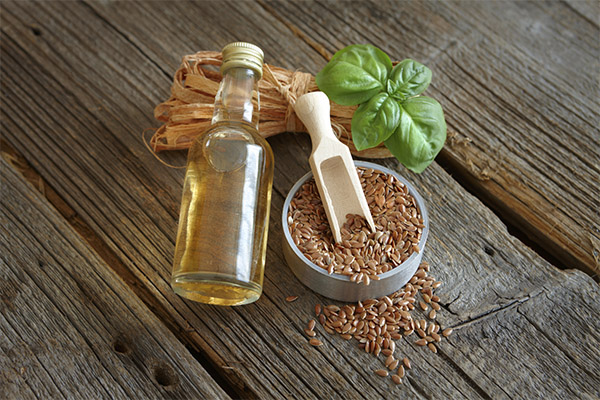
Interestingly, you can buy the product both in the supermarket and at the drugstore. Linseed oil is used not only as a food, but also as an external agent, mainly in cosmetology for the preparation of various masks. In addition, it is believed that it helps with minor cuts.
Flaxseed oil is often regarded as a dietary product. It is involved in the normalization of metabolism, it is taken as a prophylactic against cardiovascular disease and diseases of the gastrointestinal tract. The plant hormone lignan contained in it has a beneficial effect on the reproductive system. The choline (vitamin B4) in its composition is considered an excellent anti-stress agent. Also the fatty acids mentioned above improve the condition of joint tissues and cartilage.
Linseed oil does not tolerate heating, so it should not be fried on it, otherwise all the useful substances will be destroyed. The best use for it would be to add it to salads of fresh vegetables, it can also be mixed with sour cream, serving it as a sauce. Flaxseed oil has a pleasant but somewhat peculiar taste. It is best combined with porridge, potatoes, salty cottage cheese, mixed with chopped spicy greens.
You can use linseed oil for weight loss. For this purpose, it is recommended to add 1-2 tsp. of the product in the composition of the morning kefir drink. The oil should be used with caution, because it is a high-calorie product. Its caloric value is 900 kcal per 100 grams.
When storing the butter one should remember that it should not be kept in the light - it spoils quickly. It is best to keep open bottles in a dark, cool place. Its shelf life - no more than 1 month.
Urbech from flax seeds: benefits and harms
Many people have probably heard about the traditional Dagestan dessert - Urbech. It is prepared from different products, one of the most common options is linseed urbeche. It is a thick paste of chocolate color (if it is prepared from the dark seeds), which has an oily consistency. Such a dish can be spread on bread or cookies instead of jam or condensed milk. But the paste itself on the basis of linseed remains tasteless, so a little flower honey is added to it.
Urbech can be served not only with bread, but also with pancakes, cheesecakes, porridges and unsweetened cottage cheese. Some hostesses even serve it with cheese and fruit.
Urbeche has all the useful properties inherent in flaxseed:
- Normalizes metabolism, including lipid metabolism.
- Beneficial effect on the gastric mucosa, especially for gastritis and peptic ulcer disease.
- Helps with digestion due to high fiber content.
- Provides healthy skin, hair and nails.
- Reduces "bad" cholesterol in the blood, prevents cardiovascular disease and diabetes.
- It improves the musculoskeletal system, increases the elasticity of muscles and ligament tissues.
It is believed that urbeche is also useful for infectious respiratory diseases. For treatment, it is consumed with milk.
At the same time, the dish has the same disadvantages as flaxseed. It is a strong choleretic effect, because of which it should not be used by people with acute cholecystitis or kidney stones. In addition, it can also cause allergies.
Urbech is considered a nourishing product, but it can be consumed even by athletes, if you observe certain restrictions. Children are given no more than 1 tsp. per day, adults can eat 1 tbsp. This is quite enough for the dish to be beneficial and at the same time would not cause any side effects.
The benefits of flaxseed meal
Another useful product made from flax seeds is the so-called flax meal. It is considered the best choice when losing weight, as its energy value is only 270 kcal per 100 grams. The use of dishes prepared on the basis of flax flour can improve metabolism and normalize digestion.
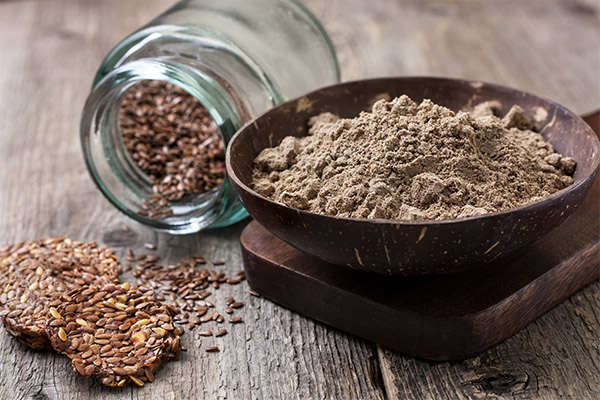
Although it is theoretically possible to grind the seeds into flour at home, it is better to buy the product produced in factory conditions. It preserved all the useful substances, including amino acids and mineral elements like zinc, magnesium and potassium. In addition, in industrial conditions it is possible to extract all the excess oils from the product, which is very important for its further storage and use. By the way, it is still recommended to keep an open bag of flour in the refrigerator.
If you decide to grind flaxseed into flour yourself, it is better to do it in small portions, so that it does not have time to spoil.
Flaxseed flour can be used for cooking various dishes. For example, it is added to baked goods, but it replaces not wheat flour, but oil and eggs, thanks to which buns and cakes quickly get a nice brown crust. It is sufficient to add as little as 10% flax flour to improve the flavor of baked goods and make them more fluffy. More useful are baked goods in which linseed flour is mixed with wheat flour in a 1:1 ratio. However, then pies and buns acquire a brown hue and a more pronounced taste. It is also worth noting that linseed flour allows you to keep the softness and freshness of bread longer.
This product is also added to cutlets, casseroles and even soups. Flax meal can also be mixed with traditional cereals to make porridge.
How to take flax seeds for weight loss
Flax seeds are called a superfood for a reason - despite the rather high caloric content, they help to lose weight. In principle, flaxseed has no effect on fat reserves. However, its unique composition acts much more effectively than most fat-burning drugs.
As noted above, this superfood contains many unsaturated acids, as well as vitamins, phytoestrogens and polysaccharides. This allows you to speed up the metabolism, normalize lipid metabolism, by stimulating intestinal peristalsis get rid of toxins, reduce blood glucose levels. In addition, flaxseed reduces appetite (the fiber it contains swells up in the stomach and causes a feeling of fullness) and helps eliminate excess fluid. Based on the above features of the product, you should not expect from it an instant weight loss. The advantage of this remedy is that weight loss occurs smoothly, without damage to health, exclusively in a natural way, and the result can be fixed for a long time.
But to get such an effect, you need to organize a systematic flaxseed intake. Previously, it is necessary to consult with a nutritionist, to clarify whether there are no contraindications and restrictions.
For weight loss, flax seeds can be taken in any form. The easiest option is to chew a small amount and drink water, which acts quite effectively. There are studies that show that with the daily use of 1-2 tbsp. seeds for a month you can lose 2 kg of excess weight (and in the presence of physical activity and more). But this recipe is considered by medics not too useful. It is better to prepare salads with flaxseeds, dressing them with unsweetened yogurt, make various drinks based on this superfood, etc.
It is worth to pay attention to such variants of using seeds for weight loss:
- Decoction. It differs from the therapeutic one by a longer preparation and a lower concentration - 1 tbsp. seed per 1.5 cups of water. It is boiled on low heat for about half an hour, stirring constantly, then cooled and divided into three intakes of 0.5 cup immediately before eating.
- Infusion differs even weaker concentration - 1 tbsp. of seeds per 400 ml of water. Such a quantity is better to insist in a thermos. After that, the drink is strained and taken in the same way as the decoction.
- Kissel. As a basis, it is recommended to take the berry kissel, already ready, in which add 1 tbsp. grinded seeds per glass of drink. Insist it for 10-15 minutes, then drink it. In fact, it is not a drink, but a meal, which replaces the meal.
- This is a dried fruit compote. This drink is boiled without sugar, add not more than 1 tbsp. of ground seeds per 1 liter, bring to a boil and cool. It is recommended to drink a little at a time, in between meals.
And, of course, on the basis of kefir and flaxseed, you can prepare a smoothie, the recipe of which will be discussed below.
Practice shows that losing weight on flaxseed not only allows you to lose weight, but also improves the condition of the skin and hair. A person feels better, he no longer has intestinal problems, which are characteristic of being overweight.
But it is not possible to use flaxseed on a permanent basis for weight loss, otherwise it can cause diarrhea. It is recommended to take any of the above drinks for two weeks, then take a break for 7 days and repeat the course. And so - no longer than four months, but all this time it is desirable to be observed by a doctor.
Flax seeds in medicine
The need for the use of flax seed in medicine is still the subject of debate.
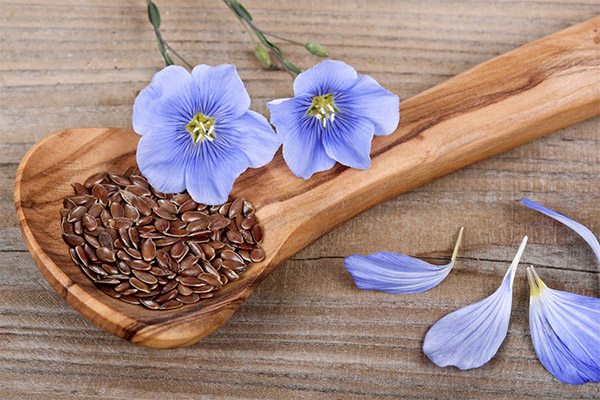
For diabetes mellitus
Flax seeds, due to their chemical composition, have the property of smoothly reducing blood glucose levels. Therefore, they are allowed to take in case of diabetes, but not at the same time as medications prescribed by the doctor.
You can take an infusion, for the preparation of which in equal proportions are used beans without grains, blueberry leaves, flax seeds and oat straw (ideally it should have been harvested at the earing stage). Measure 3 tbsp. resulting mixture (flax seeds are recommended to grind), pour 750 ml. boiling water, bring to a boil and leave on low heat for 15 minutes. Then cool and strain. Take such an infusion should be 1/3 cup three times a day with meals. Do it only after consulting a doctor. Perhaps a specialist will increase the dose to 1/2 cup.
If all the rules are followed, the patient will feel great, the feeling of constant dryness in the mouth will disappear, he will not feel thirsty as before.
Important: The glycemic index of flax seeds is 35 units.
In pancreatitis.
This is a disease of the pancreas, an organ that is involved in the production of insulin. Therefore, the ability of flaxseeds to saturate and provide vitamins without increasing blood sugar levels in this disease is very important. The enveloping effect helps to take care of the gastric mucosa and the healing of damaged gastrointestinal tissues. Nevertheless, with pancreatitis, this product is used with caution, mainly in the form of decoctions and infusions. In the acute form of the disease and flaxseed is generally contraindicated.
With gastritis
As already noted, flax seeds have enveloping properties. Therefore, they are considered an excellent remedy for gastritis with hyperacidity, because they protect the mucous membranes from the destructive action of gastric juice. However, in this case, not the seeds themselves are used, but the mucus. It is prepared by pouring the seeds with hot water and actively shaking the mixture for 15 minutes. Below the recipe will be considered in more detail. Chewing linseeds with gastritis is not allowed, its particles are too coarse and can traumatize tissues.
For the intestines
Although flaxseed is good for the intestines, it is not recommended to consume this product, especially in whole form, in acute diseases of this organ. It intensifies peristalsis, and in the presence of problems, it does not always have a good effect.
In case of constipation.
Flaxseed is considered an excellent remedy for constipation, because it improves intestinal peristalsis. You can use it only after consulting your doctor, if constipation is caused by this reason. And you can drink the above decoctions and infusions, or prepare kissels and porridges. The main thing is not to overdo it, otherwise constipation will turn into diarrhea.
When suffering from gout
There are studies, according to which flaxseed helps to reduce the level of uric acid, which is the main cause of this disease. Therefore, adding flaxseed to your diet for this disease is not a bad idea. But you have to be careful, if in doubt - it is better to start with decoctions and infusions. Prepare them in the way described above every day.
With colitis
This is an inflammatory bowel disease, in which it is not recommended to take drugs that increase peristalsis, including flaxseed.
For the liver
There is no consensus among physicians about the use of flaxseeds for liver disease. The diuretic effect of the seeds can lead to trouble. It is better to consult a doctor.
Hemorrhoids
In this disease, caution should be exercised. Although flaxseed improves digestion due to fiber, it can also have an irritant effect. It is better to use not the seeds themselves, but a decoction of them.
It is also recommended to take a complex collection on their basis of various herbs. For example, you can take in equal parts chamomile (only dried flowers), the herb sage, yarrow, nettle, shepherd's purse, mint, add the same amount of flax seeds. All these ingredients are ground beforehand. Of the resulting mixture is selected 1 tbsp. and pour boiling water. Insist this liquid in a water bath for 15 minutes. Then cool, strain, divide the resulting amount into three equal portions and drink before meals.
When cholecystitis
In chronic cholecystitis the same infusion is prescribed as in the treatment of diabetes. Flaxseed is contraindicated in acute cholecystitis.
The use of flax seeds in traditional medicine
In folk medicine, flax seeds are used for a variety of diseases, mainly in the form of decoctions and infusions. For example:
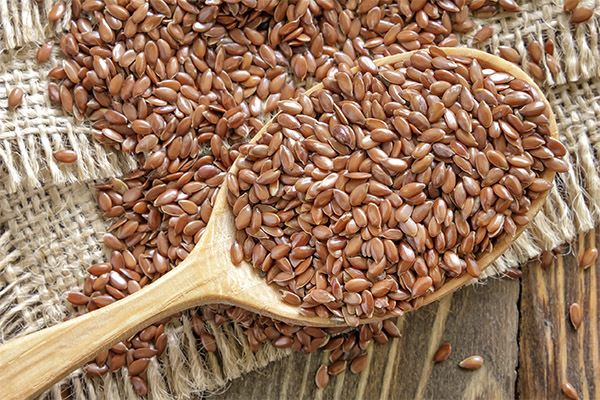
- To stimulate bile secretion and a slight diuretic effect, as well as with food poisoning. Prepare the product as follows: 1-2 tbsp. raw material pour a glass of clean water, bring to a boil, cool, strain, take 2-3 tbsp. three times a day. The course of treatment should not last more than a month, otherwise there is a risk of gallstone disease.
- With laryngitis. For 1 tbsp. seeds take a glass of milk, bring to a boil, leave for 10 minutes over low heat, strain. Take 2-3 tbsp. in the morning and at night. The hoarseness and scratchy cough quickly go away.
- With bronchitis with a dry cough, if there is no sputum, take 100 grams of ground linseed powder and mix with 0.5 liters of honey. Such a remedy should be stored in a jar of dark glass in a cool place. Take it 1 tsp. 8-10 times a day, preferably mixed with warm water. Since it deteriorates quickly, you can not prepare it for the future. If the bronchitis is accompanied by a wet cough, then additional ingredients like anise or ginger should be added to this mixture. Otherwise, the scheme of reception remains the same.
- Flaxseed is also used for healing wounds and burns, for this purpose it is mixed in equal proportions with raw egg white. This remedy is used to make lotions for small burns. However, official medicine insists that in this case there is a great risk of infection, and it is better still to turn to ready pharmaceutical preparations. All the more that the folk remedy only slightly reduces pain.
Flax seeds do not have to be taken internally. For muscle and joint pain, they are heated in a frying pan, poured into a cloth bag and applied to the affected area. This will provide dry heat and relieve pain and inflammation.
Also in folk medicine, linseed oil is widely used as a laxative or diuretic, as well as for all the diseases described above - instead of the seed itself or decoctions from it.
Flax seeds in cosmetology
Flax seeds in cosmetology are used in the form of flour, that is a powder, which is obtained by grinding the raw material in a coffee grinder. If you boil this powder and bring it to a boil, you get something like sour cream, which contains a large number of useful substances. It is suitable for hair masks, and for products designed for the skin of the face. Use such a kissel can only be freshly prepared, otherwise the useful substances will be destroyed.
Masks from flax seeds for the face
There are several recipes. The method of preparation depends on what purpose is needed. For example:
- A cleansing peeling mask. For its preparation you need 3 tbsp. of crushed oat flakes and the same amount of ground flaxseed. The mixture is poured with hot water and mixed to the consistency of sour cream, and then cooled until it is slightly warm. The mask is applied to the face with circular massage movements. Such a peeling will remove all impurities and dead cells. The rest of the prepared mixture can be applied to the skin and left for 10-15 minutes. After that the mask is washed off with warm water. The skin becomes visibly fresher and brighter.
- Nourishing mask for mature skin prone to peeling. Pour crushed linseed in boiling water as for mucilage, and insist for 15 minutes. Then the mucilage component is strained off, a little honey, sour cream and olive oil are added to it, and then stirred. The mask is applied to the skin of the face without restriction, even the skin under the eyes can be affected. The composition can also be used for sensitive skin on the neck. Thanks to the antioxidants flaxseed will give it elasticity and delay aging. The remedy is kept on the skin for 10-15 minutes, then it is thoroughly washed off.
- Mask for normal skin. It can be used quite often, for example, twice a week, because unlike ready-made lifting products, it does not contain radical components. At the same time, linseed tightens the skin and provides it with vitamins. For this mask, slime strained from the decoction is used, as in the previous recipe. Only mix it with a spoonful of cosmetic clay suitable for this type of skin, for example, blue clay. The product is applied evenly to the skin of the face and left for 15-20 minutes, and then washed off with warm water.
The advantage of linseed masks is that they are almost universal, as they are suitable for all ages. They should be used with caution except for owners of oily skin, in which such products can provoke increased production of sebum, if not balanced by some ingredients such as cosmetic clay or lemon juice.
Hair Masks
Masks for hair based on flaxseed are no less useful:
- Stimulating hair growth. You should take 2-4 tsp. of ground linseed, depending on the length of your locks, mix it with hot water at the rate of 3/4 cup per spoon and whip it till the smooth mass. It is most convenient to do this with a blender. In the ready mixture add a couple of drops of your favorite essential oil, cinnamon, orange or lavender will do. The product is applied to the scalp and hair along its entire length. The head is covered with plastic wrap and a towel on top. The mask is kept for an hour and a half, but the result is worth it. The course consists of 5-10 procedures.
- Against dandruff and itching. 1 tbsp. milled seeds take a glass of boiling water, brewed in a thermos and infused for a few hours. You get a mass, like a kissel. Mucus from it to strain and apply to the scalp. Mask held for an hour, then rinse with warm water.
Flaxseed is also used as a broth - they rinse the hair, adding there essential oils and other herbal ingredients. And they can be interspersed with ready-made remedies, there are no restrictions. These decoctions will help to make hair more manageable and less brittle, prevent hair loss.
Flaxseeds in cooking
These seeds are used for a variety of purposes. They are perfectly combined with vegetable salads, both summer and winter. They can safely be added to cottage cheese or soft cheese, sprinkled on oatmeal, bulgur, couscous and other porridges. In addition, flaxseed can be added to pumpkin, carrot or mushroom cream soup, it also goes well with vegetable stew. But in any case, it is added after boiling.
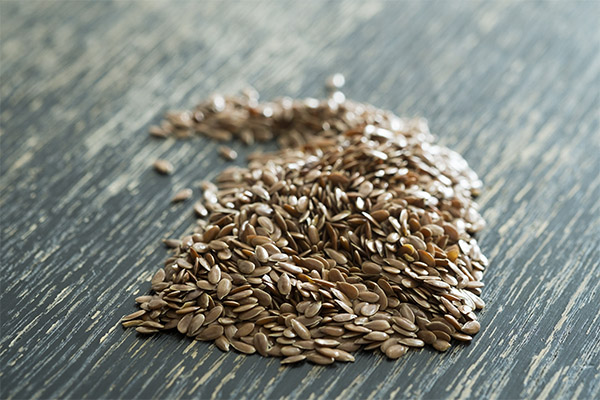
To replace the egg (with its unsafe cholesterol) in baking, linseed flour is used - 1 tbsp. per 3 tbsp. of water.
Mixing wheat flour in equal proportions with oat flour and flaxseed flour, you can bake delicious pancakes for breakfast - especially since they can be served with fresh fruit and yogurt. Similarly, ground flax seeds are mixed with flour and cottage cheese for cheesecakes. And both pancakes and cheesecakes are preferably not fried, but baked in the oven.
Harm and contraindications
Like any other product, flax seeds should be used in moderation, because otherwise there may be unpleasant feelings. If you eat them more than 1-2 tbsp. a day, there will be discomfort in the liver area.
In addition, when consuming flax seeds, some people may experience bloating and even flatulence accompanied by pain and discomfort. If there is a tendency to such reactions, you should start the use of flax seed with a small amount, such as 0.5-1 tsp. per day, gradually increasing this dose.
Very carefully take flax seeds in chronic pancreatitis and cholecystitis. And although with gastritis they are even useful, at its exacerbation it is better to limit it to mucus, because the seeds themselves can traumatize the mucous membrane. If you consume this product for a long time, other troubles can appear - for example, diarrhea and pain in the intestines. The fact is that in the presence of problems with the digestive system, the intestines may be too sensitive to the fiber contained in the seeds. In addition, in such cases, peristalsis intensifies, which leads to painful sensations. To alleviate the consequences, it is recommended to drink as much water as possible at the same time with flax seeds.
Absolute contraindications for taking flaxseed are:
- Intestinal obstruction.
- Acute cholecystitis and pancreatitis.
- The presence of gallstones in the gallbladder, since the seeds have a choleretic effect and can provoke the movement of stones and blockage of the passage.
- Gynecological diseases - uterine fibroma, endometritis, polycystic disease.
In addition, you should not use flaxseed at the same time as medications for diabetes, as blood glucose levels can drop significantly. Also, this product should be abandoned if there are symptoms of allergies.
In addition, damage can be caused by flax seeds, which have been stored incorrectly. In this case, they form very dangerous substances - carcinogenic pyroxides.
Flax seed allergy symptoms
The absence of gluten in the seeds does not mean that they do not cause allergic reactions. However, these are usually masked by symptoms of poisoning such as nausea, vomiting and diarrhoea. Very rarely do such classic signs of allergies occur as hives and other types of rash.
How to choose and store flax seeds
When buying linseeds, preference should be given to seeds that are not sold by weight, but already packaged. In this case, it is not recommended to buy ground seeds, since the oil gets out and oxidizes very quickly. In a week, the seeds can already be thrown out. Therefore, it is recommended to grind them in a coffee grinder just before taking them.
Flax seeds should not be stored in the light. The oils and fatty acids oxidize rapidly under the influence of ultraviolet light. As a result, the seeds acquire a characteristic rancid taste. Such a product should be thrown away immediately, as the appearance of the taste means the presence of carcinogenic peroxides. So store this product only in a closed container, which should be kept in a cool dry place.
Linseed oil should be bought in dark glass bottles, making sure to check the expiration date. After opening the container with oil is stored only in the refrigerator. The maximum shelf life is two weeks. Therefore, it is best to buy small bottles so that you don't have to throw the product away.
But whole, unground flax seeds can be stored for much longer. On average, they can be stored for a year.
How to Eat Flax Seeds Properly
Many experts believe that the best option for the use of flax seed is in combination with fermented dairy products. After all, such dishes become a good start to the day - they provide the necessary energy, while helping to strengthen the immune system and protect against bacteria and viruses. Also the use of seeds with low-fat dairy products helps to improve digestion and lose extra pounds.
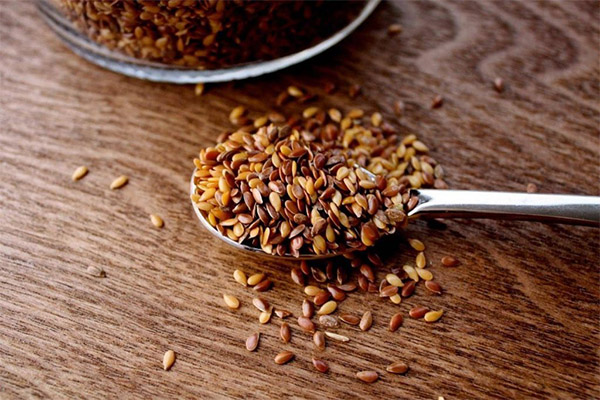
But in fact linseeds are a universal product that can be combined with literally any dish. The main thing is that they do not go through a long thermal treatment, because in this case the useful substances will be destroyed. Only the ability to envelop the mucous membranes will remain.
Thus, linseeds can be consumed by adding them to whole-grain cereals, cornflakes and muesli, which are eaten in combination with milk and yogurt. Seeds can be sprinkled on cookies and pastries, low-fat cottage cheese and soft cheese, prepare kissels, decoctions and infusions with them, which will be discussed below.
How much you can eat per day
Flax seeds should be consumed in moderation. The maximum daily dose is 30-40 g. But even this is considered excessive by many doctors, insisting on only 20 g per day. But even to this dose should go gradually.
Can I eat at night and on an empty stomach?
Adepts of folk medicine recommend consuming linseed on an empty stomach. However, physicians recommend that the decoction or infusion be drunk immediately before a meal - that is, 15 minutes. Many doctors also advise adding flaxseed to breakfast, starting the day with it.
It is not recommended to consume this product at night, especially if there is a risk of bloating and flatulence.
Can you eat them dry?
Theoretically, in small quantities, flax seeds can be eaten in dry form. But in this case they should be chewed very carefully and then drunk with water. But in general, it is not recommended to eat flaxseed in a dry form, as it can lead to dehydration of the body and worsen constipation.
Only very healthy people can eat flaxseed in dry form. These grains begin to swell only in the intestine, and if it is prone to inflammatory diseases, this can lead to unpleasant consequences.
Should we wash flax seeds before using them?
There is no consensus on this question. Theoretically, flaxseed can be washed immediately before consumption, before starting to cook something with it. In other cases, it is not necessary to do this.
How to properly brew flax seed
It all depends on what exactly you need to brew flaxseed for. For example, if we are talking about the treatment of gastritis, in this case, the most important component is mucus. Take 1 tsp. of seeds, pour a glass of boiling water and pour into a glass bottle, which is then tightly closed with a cork. For 30 minutes, this liquid is shaken by shaking the bottle vigorously. As a result, mucus is formed, which is filtered through a fine sieve or gauze. The resulting amount should be enough for the whole day - it is divided into three meals. It is recommended to use the mucus half an hour before a meal. A fresh portion should be prepared every day.
If the goal is to cleanse the body, normalize digestion and reduce appetite, then you need to prepare a decoction or infusion of the seeds. There are different ways to prepare them, but in the classic version of the broth is prepared as follows - 2 tbsp. seeds pour a glass of water, bring to a boil and leave on low heat for 10 minutes. Then insist for half an hour, filtered through a gauze or strainer and drink before eating.
Infusion is prepared even easier. In this case, the liquid will be less concentrated, 1 tsp. seeds pour a glass of boiling water and leave for 20 minutes, cover the container with a lid. Before use, the infusion is strained. The maximum amount of decoction or infusion that can be drunk during the day - 250 ml, ie glass. As a rule, such remedies are taken by courses of 10 days, and after a week and a half break, if necessary, repeat the treatment.
What can be made from flax seeds: recipes
On the basis of linseed, a variety of dishes can be prepared. The most useful options will be considered below.
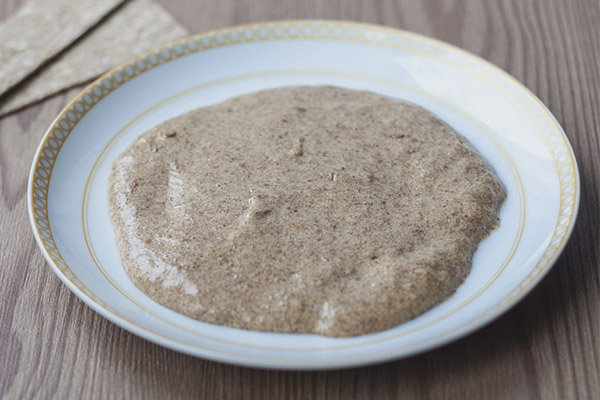
Flaxseed porridge
This is the best option if you have a constant stomachache, feel unpleasant heaviness in the intestines or had a poisoning. But remember the important rule - cook the dish and consume it at once.
You will need (per 1 serving):
- 30 g of flax seed;
- 1 tsp. honey;
- 2-3 pcs. prunes.
In the evening pour flax seeds with a mug of boiled water at room temperature. In the morning add another 100 ml of water and pre-soaked in clean water, washed prunes. Pour the mixture into a convenient container to whip it with a blender, then add honey. The result will be a liquid porridge. For the purpose of therapy, you need to take it at least 14 days twice a day, ideally for breakfast and before going to bed.
Kissel
Flaxseed kissel is most often prepared for the treatment of pancreatitis. But, of course, it can also be drunk by healthy people who have no contraindications. Take 2 tbsp. flaxseed, grind in a coffee grinder, pour boiling water (at the rate of 1 cup per spoon). Stir and simmer over low heat for about 10 minutes, be sure to bring to a boil. Then insist for an hour, strain, add a little honey.
If there are no dietary restrictions, the kissel can be prepared differently. Take 100 grams of linseed, 1 liter of boiled and cooled water, any fruit and berries - 100 grams, honey - to taste. Kissel start preparing in the evening. To do this, pour water into a pot, pour the seeds and fruits or berries. In the morning, all you need to do is to whip the mixture with a blender. In the morning it is enough to simply whip the resulting mixture with a blender. However, for a long time this "live" kissel can not be stored in any case, it must be drunk immediately.
Smoothie
Smoothie with flaxseed is recommended to prepare on the basis of fermented dairy products, such as kefir. For one serving (its energy value will be 210 kcal) take a glass of kefir, 1 tsp. ground flaxseed, the same amount of raisins, 2 prunes, cinnamon, honey and ginger to taste. All the ingredients are mixed, then chopped with an immersion blender and slightly whipped. The smoothie is served chilled. Instead of kefir, unsweetened yogurt without additives can be used.
Can I Give Flax Seeds to Animals
There is no consensus among scientists about this ingredient. On the one hand, the omega-3 fatty acids contained in this product have been found to be beneficial for the skin and coat of the pet. A lack of these acids causes the coat to lose its shine and thickness, becoming weak and brittle. This deficiency also leads to eczema and dermatitis, and slow healing of any wounds. However, experts say that the fatty acids contained in flaxseed, the bodies of pets are poorly absorbed, so with this product they get very little useful substances. For carnivores (which cats and dogs are, in fact, the best source of omega-3 acids is fish oil.
However, many manufacturers produce special foods that contain granulated flaxseed. It is much more digestible than regular grains.
Interesting Facts about Flax Seeds
- Currently, flax seeds are used to prepare more than three hundred different products. But they are most often used in the baking industry. Baking with flax seeds is especially popular in Germany. Here annually this industry uses about 60 thousand tons of seeds, i.e. for each German there is about 1 kg.
- In Canada this product is also recognized as very promising. And in that country, it has the status of a food product, not a food additive. Also on the state level there were recommendations to include up to 12% of flaxseed in bread and baked goods produced industrially. Demand for this product is gradually growing in Russia as well.
«Important: All information on the site is provided for informational purposes only purposes. Before applying any recommendations, consult with a specialized specialist. Neither the editors nor the authors shall be liable for any possible harm caused by materials."

